Do you know the importance of the insemination rate?
Dairy farming is a very complex activity where different sectors can influence. Nutrition, welfare, reproduction, management, all work as a gear where if one of these sectors is not performing well, it can significantly compromise the others.
Specifically talking about reproduction, the focus is always on making more cows pregnant. That way, besides having more calves per year, we’ll keep a higher percentage of lactating cows, generating more income for the farm.
The main indicator of reproductive efficiency is the Pregnancy Rate (PR). It directly involves two other indicators, the Conception Rate (CR) and the Insemination Rate (IR). Today’s goal is to better understand how the IR influences the economic results in a dairy farm.
But what is the insemination rate?
The IR can be calculated by dividing the number of inseminations in the last 21 days by the number of cows eligible to be inseminated in the same period. Eligible cows are all the cows except the pregnant and freshly calved cows that have not been liberated for reproduction yet (voluntary waiting period).
This indicator shows us 2 possible problems occurring with the animals:
1 – Anestrus: cows that are not cycling, due to several factors such as low body condition score, nutritional deficiencies, metabolic diseases, post-calving problems in general, etc.
2 – Failures in heat observation: in this case, the cows are cycling, presenting heat, but many of them are not being inseminated because they were not identified in heat.
Therefore, we conclude that a low IR does not allow us to obtain a satisfactory pregnancy rate. So, to get pregnant cows, you have to inseminate them!

Source: UNIFORM-Agri (SmartMilk) – PDPL
Is there an influence on economic results?
To answer this question, we analyzed reproductive and economic data from 30 dairy farms in the Zona da Mata region (Minas Gerais state/Brazil), assisted by the Dairy Farming Development Program (PDPL-UFV) in the period June/2020 to May/2021. The reproductive data were obtained from the Software UNIFORM-Agri (SmartMilk).
From these 30 farms, we created two groups with the 6 (20%) best (blue) and worst (red) Insemination Rates. (Graph 1).
From then on, keeping always this same sample of upper and lower groups for IR, we analyzed other indicators.
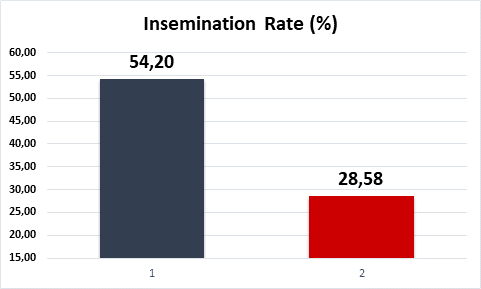
Source: PDPL
Pregnancy rate (PR)
A major benefit in increasing the IR is the increment in the PR. In this study, the result was no different. (Graph 2)
We can notice here that the group of producers with higher IR obtained almost 10 extra points of PR. This means between 6 and 7 more pregnancies per month in a herd with 50 eligible females.
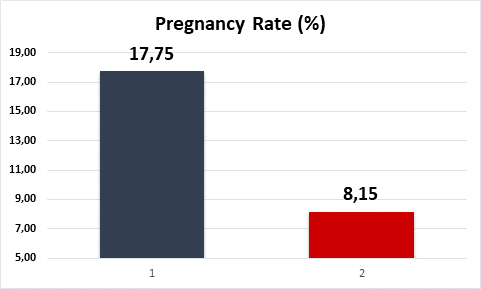
Source: PDPL
Net margin per liter of milk (NM/L)
This indicator can be calculated by subtracting from the gross income of the activity (milk and animal sales amounts, for example). The total operational cost (TOC), which includes all the direct expenses of the activity (workforce, feed, electric power, fuel, minerals, medicines, etc) and also the value of the family work, and the depreciation of constructions, machines, equipment, non-annual forage and service animals. An important difference of Net Margin to a Cash Flow, for example, is that it does not only take into account inputs and outputs, it also includes indirect expenses such as family work and depreciations.
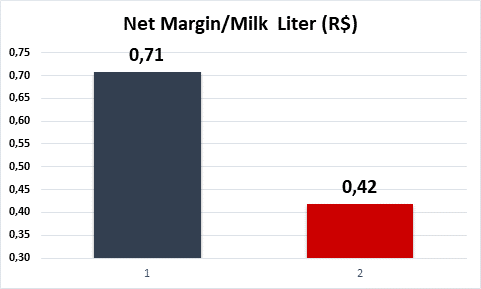
Source: PDPL
In the study in question, the group of farmers with better IR efficiency had an NM of R$0.29/Extra liter of milk. (Graph 3)
Given this difference in NM/L, we may illustrate how a farm producing 1,000L per day would have R$8,700 more by the end of the month! Is it worth the investment in breeding?
Return rate on invested capital (ICR)
One of the most complete economic indicators is the Return Rate on Invested Capital. We can calculate it by dividing the annual net margin of the activity by the capital stock (all the goods of the property: animals, machines, constructions, etc). In other words, it means everything that was invested, how much is returning to the farmer per year (in percentage).
Once more, the most efficient farms in IR made better returns on investments in the activity, presenting a difference of almost 17 percentage points per year. (Graph 4)
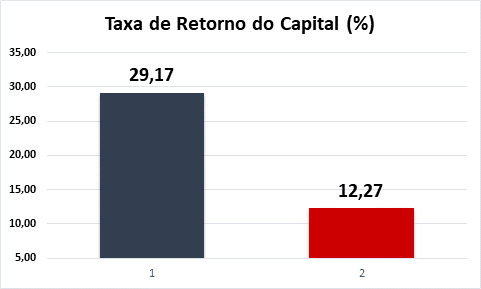
Source: PDPL
How to increase the insemination rate?
Considering the results, it is clear how important it is to invest in IR. But how to do it?
Here are some actions to contribute to improving these numbers:
- Prepartum: A good prepartum will minimize metabolic and infectious problems in the postpartum, which may directly affect the cows’ cyclicity;
- Comfort and welfare: Any factor that affects the comfort and welfare of the cows will directly affect reproduction, not only in the conception but also in the cyclicity and heat manifestation;
- AI: The Artificial Insemination in Fixed Time allows the insemination of more cows in a shorter space of time, besides eliminating the chance of lost heat observation;
- Heat observation: Even using AI, a good heat observation is always necessary. Cows that don’t become pregnant at the first insemination will be in heat again and this needs to be identified for re-insemination. Some tools and practices help these observations, such tools can be used individually or together, depending on the system and practices of each property;
- Workforce training: it is important to keep the staff always aware of the main signs of heat in cows and heifers;
- Floor: a slippery and/or very irregular floor decreases the number of mounting and thus the chances of that female being observed in heat;
- Avoid overcrowding in barns: cows need space to perform mounts at the time of heat;
- Minimize hoof problems: hoof problems also decrease the number and duration of mountings;
- Bulls: for animals bred out of barns it can be an interesting strategy as the bull ruffian mounts more times a day, increasing the chances of heat observation;
- Marker stick: the idea of this tool is to paint the base of the animal’s tail daily and observe if this paint has been removed (by a possible mount);
- Stickers: These stickers are like “scratch cards” and are also glued on the base of the tail and when the female is mounted, when “scratched” it shows a bright color, suggesting that the animal has accepted mounting;
- Electronic activity systems: These devices detect through daily step count the activity increase that occurs in females in heat. This is notified to the farmer, identifying the animal and the best time to perform the insemination.
Conclusion
Many simple and affordable strategies can be used to increase the insemination rate. This indicator has a direct relationship with the number of pregnancies increase in the year and also with the profitability in dairy farms. However, to control reproductive results, we first need the collaborators’ team to make the necessary notes (inseminations dates, calving, heat, etc.) and then, with the support of a good software as UNIFORM-Agri (SmartMilk), generate and analyze the indicators, to take the most assertive decisions for the technical and economic sustainability of the activity.
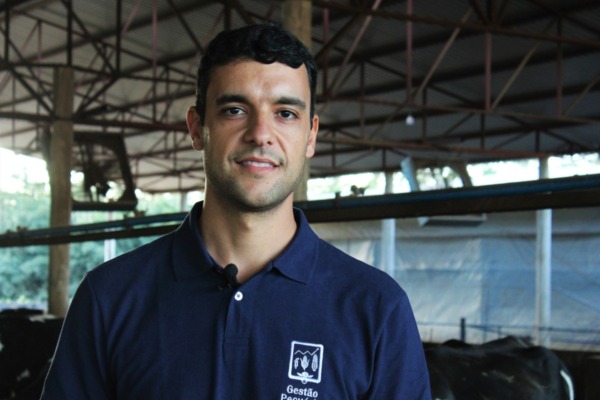
André Navarro Lobato
BS in Veterinary – Universidade Federal de Viçosa (UFV)
MSc in Ruminants Production and Nutrition – Universidade Federal de Viçosa (UFV)
Veterinarian at PDPL – Viçosa-MG/Brazil
Managing partner at Gestão Pecuária Agricultura Company
Post-Graduate Professor in Dairy Cattle at CENVA

